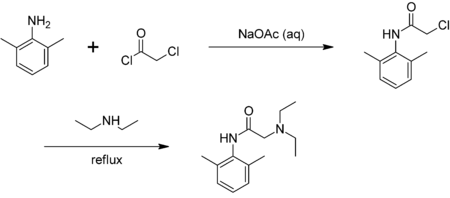- Chloroacetyl chloride
-
Chloroacetyl chloride 
 chloroacetyl chloride
chloroacetyl chlorideIdentifiers CAS number 79-04-9 
PubChem 6577 ChemSpider 6329 
EC number 201-171-6 KEGG C14859 
Jmol-3D images Image 1 - C(C(=O)Cl)Cl
Properties Molecular formula C2H2Cl2O Molar mass 112.94 g mol−1 Appearance Colorless liquid Density 1.42 g/mL Melting point -22 °C, 251 K, -8 °F
Boiling point 106 °C, 379 K, 223 °F
Solubility in water Reacts Hazards MSDS Oxford MSDS EU classification  T
T  N
N  C
C chloride (verify) (what is:
chloride (verify) (what is:  /
/ ?)
?)
Except where noted otherwise, data are given for materials in their standard state (at 25 °C, 100 kPa)Infobox references Chloroacetyl chloride is a chlorinated acyl chloride. It is a bifunctional compound, making it a useful building block chemical.
Contents
Production
Industrially, it is produced by the carbonylation of methylene chloride, oxidation of vinylidene chloride, or the addition of chlorine to ketene.[1] It may be prepared from chloroacetic acid and thionyl chloride, phosphorus pentachloride, or phosgene.
Reactions
Chloroacetyl chloride is bifunctional—the acyl chloride easily forms esters[2] and amides, while the other end of the molecule is able to form other linkages, e.g. with amines. The use of chloroacetyl chloride in the synthesis of lidocaine is illustrative:[3]
Applications
The major use of chloroacetyl chloride is as an intermediate in the production of alachlor and butachlor; an estimated 100 million pounds are used annually. Some chloroacetyl chloride is also used to produce phenacyl chloride, another chemical intermediate, also used as a tear gas.[1] Phenacyl chloride is synthesized in a Friedel-Crafts acylation of benzene, with an aluminium chloride catalyst:[4]
Safety
Like other acyl chlorides, reaction with other protic compounds such as amines, alcohols, and water generates hydrochloric acid, making it a lachrymator.
References
- ^ a b Paul R. Worsham (1993). "15. Halogenated Derivatives". In Zoeller, Joseph R.; Agreda, V. H., eds. (Google Books excerpt). Acetic acid and its derivatives. New York: M. Dekker. pp. 288–298. ISBN 0-8247-8792-7. http://books.google.com/?id=3MjdGp1v1YIC&pg=RA2-PA288.
- ^ Robert H. Baker and Frederick G. Bordwell (1955), "tert-Butyl acetate", Org. Synth., http://www.orgsyn.org/orgsyn/orgsyn/prepContent.asp?prep=cv3p0141; Coll. Vol. 3
- ^ T. J. Reilly (1999). "The Preparation of Lidocaine". J. Chem. Ed. 76 (11): 1557. doi:10.1021/ed076p1557. http://jchemed.chem.wisc.edu/Journal/Issues/1999/Nov/abs1557.html.
- ^ Nathan Levin and Walter H. Hartung (1955), "ω-Chloroisonitrosoacetophenone", Org. Synth., http://www.orgsyn.org/orgsyn/orgsyn/prepContent.asp?prep=cv3p0191; Coll. Vol. 3: 191
Categories:- Acyl chlorides
Wikimedia Foundation. 2010.


